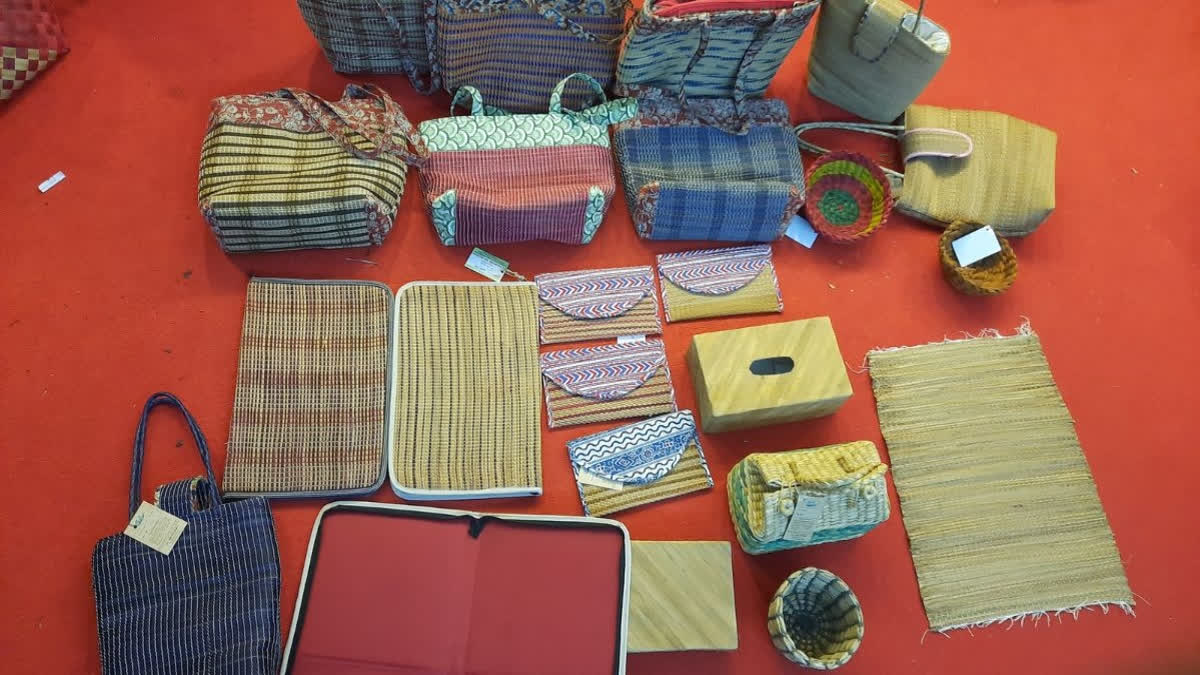Thrissur/Alappuzha: The workstation of Kottappuram Integrated Development Society (KIDS) in the Thrissur district of Kerala is a mess of plastic wires at a glance. On a closer look, it becomes evident that the women here are dealing with dried water hyacinths and palm leaves.
These women from the town bordering Ernakulam district have been earning a livelihood by making home decor items from eco-friendly raw materials. Launched in 1987, KIDS has been creating products from palm leaves and screw pines by weaving and using looms. The traditional knowledge of processing innovative products reached its helm when the women workers explored the hidden potential of water hyacinths in 2005.
They were the first in India to introduce a loom system for creating products from dried hyacinth stems.“Technology has brought about changes, but sound knowledge of traditional practices is our core strength. Around 600 women reap benefits by collecting, cleaning, drying, or making products from screw pines, palm leaves and water hyacinths. Of them, 150 exclusively deal with hyacinths. All are members of local Kudumbashree units,” said Fr Paul Thomas Kalathil, Executive Director of KIDS.
When they get several orders at a time, they double the workforce by temporarily employing women from neighbouring villages, thus transforming the stems into ladies’ handbags and purses, file folders, tissue paper boxes, table and flower pots, table and floor mats, and small baskets. Vimala Jose (60) from Kara in Thrissur district, has been associated with KIDS for the last 22 years.“In the initial stages, we faced challenges in the collection and drying of stems, and the dyeing process. However, traditional knowledge and expert training guided us... Even during the Covid-19 period, we did not face shortage of orders," Jose told 101Reporters.
According to Jose, they have four action groups. The first one based in villages will collect hyacinths from water bodies, segregate stems and forward it for drying. The second group is involved in dyeing the stems with various natural colour variants, while the third convert them into flexible materials using looms. The fourth group makes finished products. There is a fifth group taking up sales initiatives at pavilions and exhibitions.KIDS has an e-commerce website and permanent sales pavilions, one of which is at Muziris Heritage Town, a few km from Kottappuram. Even for setting up sales pavilions and field activities, KIDS sticks to a community–participation approach.PPP modelNeelamperoor panchayat in Alappuzha district has a public-private partnership (PPP) model for water hyacinths with Rope Enterprises Private Limited, a Madurai-based startup.
Initially, Rope Enterprises collected hyacinths from Kainakary through local workers/contractors, but the strategy did not work well.They connected with Haritha Kerala Mission (HKM) through contacts, which paved the way for hyacinth collection from Alappuzha municipal area in early 2022.
As Rope Enterprises needed large quantities, HKM connected the company with Neelamperoor panchayat by year-end. Rope Enterprises collects hyacinths based on their requirement, mostly in every three to four months."Nearly 300 women, including Kudumbashree members and MGNREGA workers, got substantial benefits. The full amount goes to them, the panchayat does not claim any of it,” Neelamperoor village panchayat president TK Thankachan told 101Reporters.
Now, more panchayats have approached HKM for similar revenue-generating projects.“We will expand to more panchayats, but nothing has been finalised yet,” said Sreejith Nedumpally, co-founder and managing director of Rope Enterprises, which pays Rs 10 per kg for dried hyacinth stems and Rs 7 for fresh ones.
“Earlier also, we got enquiries for small quantities and we supported them. Before Neelamperoor, PPP was implemented in the canals of the Alappuzha municipal area,” T N Seema, a former Rajya Sabha member and HKM state coordinator told 101Reporters. The biggest challenge is to dry up the hyacinths in monsoons as the rainy season lasts for several months in Kerala. Unlike in Alappuzha, Neelamperoor does not have a ground where they can dry it.
On many occasions, the buyer is forced to collect fresh hyacinths (90 per cent water) for a high price. “We prefer dried stems,” said Nedumpally. Rope Enterprises employs over 300 women in its Tamil Nadu unit. A double-edged sword water hyacinths may have brightened up the lives of several women in both states, but their ill effects on the environment cannot be disregarded. Every year, the Irrigation Department and local bodies in Kerala spend substantial amounts to remove hyacinths, a hazardous waste that severely damages the quality of water bodies. Earlier, when a majority of the rural population was engaged in agriculture, people used to clear it regularly. With the changing times, hyacinth has been gobbling up water bodies so much so that they affect agriculture, fishing, inland navigation and tourism. Mosquitoes breed in them, increasing the risk of malaria and dengue fever.
A leading tour operator in Changanassery town, Sabu Thomas (55) said hyacinths impeded the natural flow of excess water during rains, triggering flash floods.“Aquatic weeds have a fast growth rate and multiple modes of reproduction channels. With their thick-hard roots connected, they can divert the flow, especially in small canals,” observed K. Omanakuttan (50), a duck farmer from Nedumudi.
Water hyacinths in large quantities even block sunlight and oxygen, choking fish habitations and affecting local breeds. For clearing purposes, JCB earthmovers have to be employed.“Kulavazha (Eichhornia crassipes) and Kadakal (a local breed that is like a secondary growth on hyacinths) are nightmares of boat drivers. Sometimes they get tangled on the propellers, and boatmen have to dive in to clear it out,” he added. (IANS/101reporters.com)
Read More:



